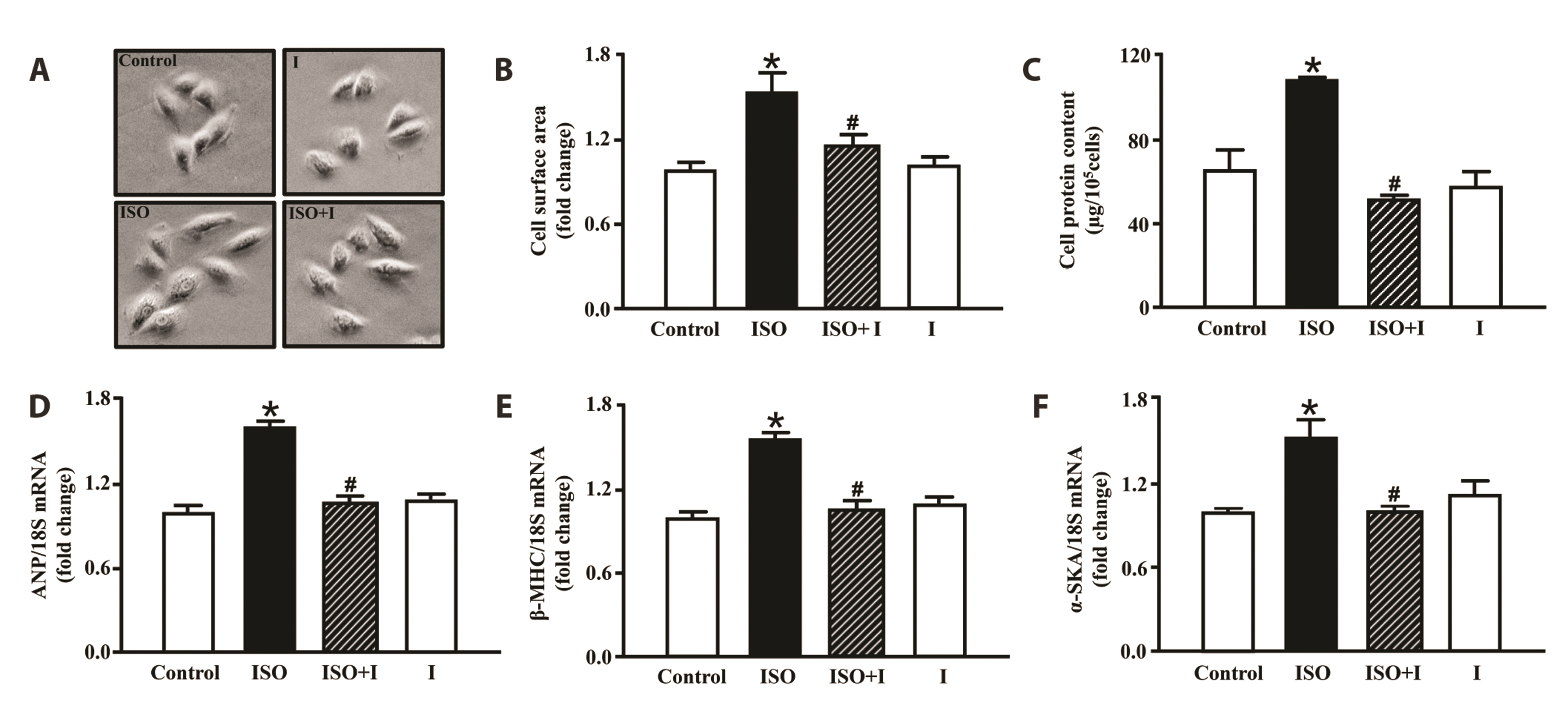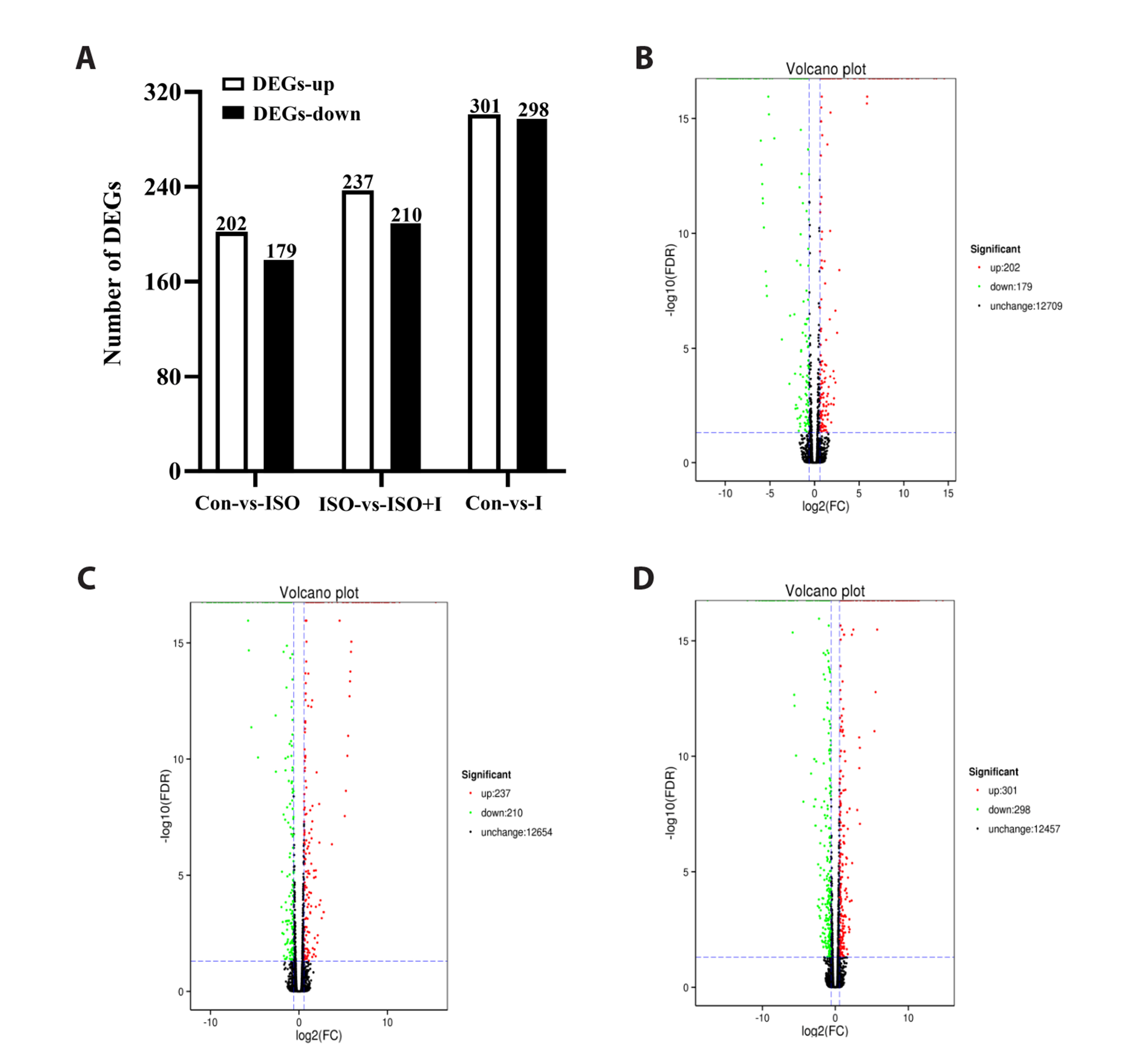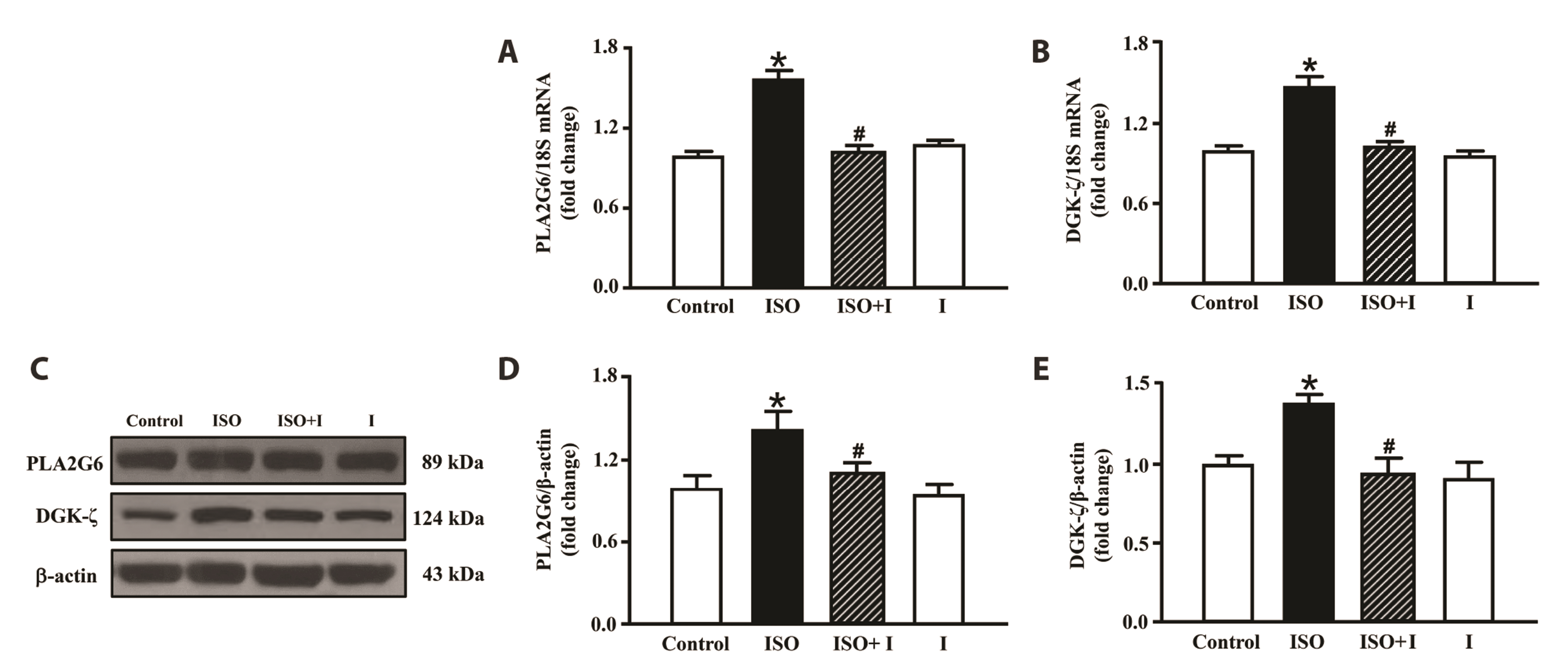Korean J Physiol Pharmacol.
2023 Jan;27(1):75-84. 10.4196/kjpp.2023.27.1.75.
Momordicine I alleviates isoproterenol-induced cardiomyocyte hypertrophy through suppression of PLA2G6 and DGK-ζ
- Affiliations
-
- 1School of Pharmacy, Jiangxi Science & Technology Normal University, Nanchang 330013, China
- 2Department of Cardiology, Jiangxi Provincial People’s Hospital Affiliated to Nanchang University, Nanchang 330006, China
- 3Key Laboratory of Modern Preparation of Chinese Medicine, Ministry of Education, Jiangxi University of Chinese Medicine, Nanchang 330004, China
- 4Jiangxi Provincial Key Laboratory of Drug Design and Evaluation, Nanchang 330013, China
- KMID: 2537505
- DOI: http://doi.org/10.4196/kjpp.2023.27.1.75
Abstract
- This study aimed to observe the protective effect of momordicine I, a triterpenoid compound extracted from momordica charantia L., on isoproterenol (ISO)-induced hypertrophy in rat H9c2 cardiomyocytes and investigate its potential mechanism. Treatment with 10 μM ISO induced cardiomyocyte hypertrophy as evidenced by increased cell surface area and protein content as well as pronounced upregulation of fetal genes including atrial natriuretic peptide, β-myosin heavy chain, and α-skeletal actin; however, those responses were markedly attenuated by treatment with 12.5 μg/ml momordicine I. Transcriptome experiment results showed that there were 381 and 447 differentially expressed genes expressed in comparisons of model/control and momordicine I intervention/model, respectively. GO enrichment analysis suggested that the anti-cardiomyocyte hypertrophic effect of momordicine I may be mainly associated with the regulation of metabolic processes. Based on our transcriptome experiment results as well as literature reports, we selected glycerophospholipid metabolizing enzymes group VI phospholipase A 2 (PLA2G6) and diacylglycerol kinase ζ (DGK-ζ) as targets to further explore the potential mechanism through which momordicine I inhibited ISO-induced cardiomyocyte hypertrophy. Our results demonstrated that momordicine I inhibited ISO-induced upregulations of mRNA levels and protein expressions of PLA2G6 and DGK-ζ. Collectively, momordicine I alleviated ISO-induced cardiomyocyte hypertrophy, which may be related to its inhibition of the expression of glycerophospholipid metabolizing enzymes PLA2G6 and DGK-ζ.
Figure
Reference
-
1. Sagris M, Antonopoulos AS, Theofilis P, Oikonomou E, Siasos G, Tsalamandris S, Antoniades C, Brilakis ES, Kaski JC, Tousoulis D. 2022; Risk factors profile of young and older patients with myocardial infarction. Cardiovasc Res. 118:2281–2292. DOI: 10.1093/cvr/cvab264. PMID: 34358302. PMID: https://www.scopus.com/inward/record.uri?partnerID=HzOxMe3b&scp=85135382443&origin=inward.2. Tham YK, Bernardo BC, Huynh K, Ooi JYY, Gao XM, Kiriazis H, Giles C, Meikle PJ, McMullen JR. 2018; Lipidomic profiles of the heart and circulation in response to exercise versus cardiac pathology: a resource of potential biomarkers and drug targets. Cell Rep. 24:2757–2772. DOI: 10.1016/j.celrep.2018.08.017. PMID: 30184508. PMID: https://www.scopus.com/inward/record.uri?partnerID=HzOxMe3b&scp=85052909594&origin=inward.3. David CEB, Lucas AMB, Cunha PLO, Viana YIP, Yoshinaga MY, Miyamoto S, Filho ABC, Varela ALN, Kowaltowski AJ, Facundo HT. 2022; Calorie restriction changes lipidomic profiles and maintains mitochondrial function and redox balance during isoproterenol-induced cardiac hypertrophy. J Physiol Biochem. 78:283–294. DOI: 10.1007/s13105-021-00863-4. PMID: 35023023. PMID: https://www.scopus.com/inward/record.uri?partnerID=HzOxMe3b&scp=85122782360&origin=inward.4. Dong S, Zhang R, Liang Y, Shi J, Li J, Shang F, Mao X, Sun J. 2017; Changes of myocardial lipidomics profiling in a rat model of diabetic cardiomyopathy using UPLC/Q-TOF/MS analysis. Diabetol Metab Syndr. 9:56. DOI: 10.1186/s13098-017-0249-6. PMID: 28736579. PMCID: PMC5520292. PMID: https://www.scopus.com/inward/record.uri?partnerID=HzOxMe3b&scp=85025078604&origin=inward.5. Blunsom NJ, Gomez-Espinosa E, Ashlin TG, Cockcroft S. 2019; Sustained phospholipase C stimulation of H9c2 cardiomyoblasts by vasopressin induces an increase in CDP-diacylglycerol synthase 1 (CDS1) through protein kinase C and cFos. Biochim Biophys Acta Mol Cell Biol Lipids. 1864:1072–1082. DOI: 10.1016/j.bbalip.2019.03.002. PMID: 30862571. PMCID: PMC6495107. PMID: https://www.scopus.com/inward/record.uri?partnerID=HzOxMe3b&scp=85062812354&origin=inward.6. Takahashi H, Takeishi Y, Seidler T, Arimoto T, Akiyama H, Hozumi Y, Koyama Y, Shishido T, Tsunoda Y, Niizeki T, Nozaki N, Abe J, Hasenfuss G, Goto K, Kubota I. 2005; Adenovirus-mediated overexpression of diacylglycerol kinase-zeta inhibits endothelin-1-induced cardiomyocyte hypertrophy. Circulation. 111:1510–1516. DOI: 10.1161/01.CIR.0000159339.00703.22. PMID: 15781737. PMID: https://www.scopus.com/inward/record.uri?partnerID=HzOxMe3b&scp=20144389232&origin=inward.7. Jia S, Shen M, Zhang F, Xie J. 2017; Recent advances in Momordica charantia: functional components and biological activities. Int J Mol Sci. 18:2555. DOI: 10.3390/ijms18122555. PMID: 29182587. PMCID: PMC5751158. PMID: https://www.scopus.com/inward/record.uri?partnerID=HzOxMe3b&scp=85036544468&origin=inward.8. Liu Z, Gong J, Huang W, Lu F, Dong H. 2021; The effect of Momordica charantia in the treatment of diabetes mellitus: a review. Evid Based Complement Alternat Med. 2021:3796265. DOI: 10.1155/2021/3796265. PMID: 33510802. PMCID: PMC7826218. PMID: https://www.scopus.com/inward/record.uri?partnerID=HzOxMe3b&scp=85099903765&origin=inward.9. Wen JJ, Li MZ, Gao H, Hu JL, Nie QX, Chen HH, Zhang YL, Xie MY, Nie SP. 2021; Polysaccharides from fermented Momordica charantia L. with Lactobacillus plantarum NCU116 ameliorate metabolic disorders and gut microbiota change in obese rats. Food Funct. 12:2617–2630. DOI: 10.1039/D0FO02600J. PMID: 33634806. PMID: https://www.scopus.com/inward/record.uri?partnerID=HzOxMe3b&scp=85103480854&origin=inward.10. Yang YS, Wu NY, Kornelius E, Huang CN, Yang NC. 2022; A randomized, double-blind, placebo-controlled trial to evaluate the hypoglycemic efficacy of the mcIRBP-19-containing Momordica charantia L. fruit extracts in the type 2 diabetic subjects. Food Nutr Res. 66:3685. DOI: 10.29219/fnr.v66.3685. PMID: 35140559. PMCID: PMC8788657. PMID: c80452100f314fab90d29cc70b725d16. PMID: https://www.scopus.com/inward/record.uri?partnerID=HzOxMe3b&scp=85128399102&origin=inward.11. Keller AC, Ma J, Kavalier A, He K, Brillantes AM, Kennelly EJ. 2011; Saponins from the traditional medicinal plant Momordica charantia stimulate insulin secretion in vitro. Phytomedicine. 19:32–37. DOI: 10.1016/j.phymed.2011.06.019. PMID: 22133295. PMCID: PMC3389550. PMID: https://www.scopus.com/inward/record.uri?partnerID=HzOxMe3b&scp=82755189591&origin=inward.12. Dwijayanti DR, Shimada T, Ishii T, Okuyama T, Ikeya Y, Mukai E, Nishizawa M. 2020; Bitter melon fruit extract has a hypoglycemic effect and reduces hepatic lipid accumulation in ob/ob mice. Phytother Res. 34:1338–1346. DOI: 10.1002/ptr.6600. PMID: 31845444. PMID: https://www.scopus.com/inward/record.uri?partnerID=HzOxMe3b&scp=85076766699&origin=inward.13. Sur S, Steele R, Isbell TS, Venkata KN, Rateb ME, Ray RB. 2021; Momordicine-I, a bitter melon bioactive metabolite, displays anti-tumor activity in head and neck cancer involving c-met and downstream signaling. Cancers (Basel). 13:1432. DOI: 10.3390/cancers13061432. PMID: 33801016. PMCID: PMC8003975. PMID: 85f8afb5522743ea8bb4741fc9052940. PMID: https://www.scopus.com/inward/record.uri?partnerID=HzOxMe3b&scp=85102685622&origin=inward.14. Chen PY, Shih NL, Hao WR, Chen CC, Liu JC, Sung LC. 2018; Inhibitory effects of momordicine I on high-glucose-induced cell proliferation and collagen synthesis in rat cardiac fibroblasts. Oxid Med Cell Longev. 2018:3939714. DOI: 10.1155/2018/3939714. PMID: 30402205. PMCID: PMC6196925. PMID: https://www.scopus.com/inward/record.uri?partnerID=HzOxMe3b&scp=85056253666&origin=inward.15. Shang L, Pin L, Zhu S, Zhong X, Zhang Y, Shun M, Liu Y, Hou M. 2019; Plantamajoside attenuates isoproterenol-induced cardiac hypertrophy associated with the HDAC2 and AKT/GSK-3β signaling pathway. Chem Biol Interact. 307:21–28. DOI: 10.1016/j.cbi.2019.04.024. PMID: 31009642. PMID: https://www.scopus.com/inward/record.uri?partnerID=HzOxMe3b&scp=85064639704&origin=inward.16. Gao S, Zhang Q, Tian C, Li C, Lin Y, Gao W, Wu D, Jiao N, Zhu L, Li W, Zhu R, Wang W, Wang Y. 2020; The roles of Qishen granules recipes, Qingre Jiedu, Wenyang Yiqi and Huo Xue, in the treatment of heart failure. J Ethnopharmacol. 249:112372. DOI: 10.1016/j.jep.2019.112372. PMID: 31683036. PMID: https://www.scopus.com/inward/record.uri?partnerID=HzOxMe3b&scp=85075378732&origin=inward.17. Jin T, Lin J, Gong Y, Bi X, Hu S, Lv Q, Chen J, Li X, Chen J, Zhang W, Wang M, Fu G. 2021; iPLA2β contributes to ER stress-induced apoptosis during myocardial ischemia/reperfusion injury. Cells. 10:1446. DOI: 10.3390/cells10061446. PMID: 34207793. PMCID: PMC8227999. PMID: 023c908438c945ffb7bf1b6d77c13e8c. PMID: https://www.scopus.com/inward/record.uri?partnerID=HzOxMe3b&scp=85110305695&origin=inward.18. Takeda M, Kagaya Y, Takahashi J, Sugie T, Ohta J, Watanabe J, Shirato K, Kondo H, Goto K. 2001; Gene expression and in situ localization of diacylglycerol kinase isozymes in normal and infarcted rat hearts: effects of captopril treatment. Circ Res. 89:265–272. DOI: 10.1161/hh1501.094185. PMID: 11485977. PMID: https://www.scopus.com/inward/record.uri?partnerID=HzOxMe3b&scp=0035800890&origin=inward.19. Nakamura M, Sadoshima J. 2018; Mechanisms of physiological and pathological cardiac hypertrophy. Nat Rev Cardiol. 15:387–407. DOI: 10.1038/s41569-018-0007-y. PMID: 29674714. PMID: https://www.scopus.com/inward/record.uri?partnerID=HzOxMe3b&scp=85045747976&origin=inward.20. Liu Y, Chen J, Fontes SK, Bautista EN, Cheng Z. 2022; Physiological and pathological roles of protein kinase A in the heart. Cardiovasc Res. 118:386–398. DOI: 10.1093/cvr/cvab008. PMID: 33483740. PMCID: PMC8803072. PMID: https://www.scopus.com/inward/record.uri?partnerID=HzOxMe3b&scp=85123969706&origin=inward.21. Czompa A, Gyongyosi A, Szoke K, Bak I, Csepanyi E, Haines DD, Tosaki A, Lekli I. 2017; Effects of Momordica charantia (bitter melon) on ischemic diabetic myocardium. Molecules. 22:488. DOI: 10.3390/molecules22030488. PMID: 28335529. PMCID: PMC6155383. PMID: https://www.scopus.com/inward/record.uri?partnerID=HzOxMe3b&scp=85016285017&origin=inward.22. Cui WW, Ye C, Wang KX, Yang X, Zhu PY, Hu K, Lan T, Huang LY, Wang W, Gu B, Yan C, Ma P, Qi SH, Luo L. 2022; Momordica. charantia-derived extracellular vesicles-like nanovesicles protect cardiomyocytes against radiation injury via attenuating DNA damage and mitochondria dysfunction. Front Cardiovasc Med. 9:864188. DOI: 10.3389/fcvm.2022.864188. PMID: 35509278. PMCID: PMC9058095. PMID: 20f40213d7f1470baaccdffc8eb74cd9. PMID: https://www.scopus.com/inward/record.uri?partnerID=HzOxMe3b&scp=85138659076&origin=inward.23. Białek A, Białek M, Lepionka T, Pachniewicz P, Czauderna M. 2021; Oxysterols and lipidomic profile of myocardium of rats supplemented with pomegranate seed oil and/or bitter melon aqueous extract - cardio-oncological animal model research. Chem Phys Lipids. 235:105057. DOI: 10.1016/j.chemphyslip.2021.105057. PMID: 33515592. PMID: https://www.scopus.com/inward/record.uri?partnerID=HzOxMe3b&scp=85100404502&origin=inward.24. Saliu JA, Oyeleye SI, Olasehinde TA, Oboh G. 2022; Modulatory effects of stonebreaker (Phyllanthus amarus) and bitter gourd (Momordica charantia) on enzymes linked with cardiac function in heart tissue of doxorubicin-stressed rats. Drug Chem Toxicol. 45:331–339. DOI: 10.1080/01480545.2019.1700271. PMID: 31823659. PMID: https://www.scopus.com/inward/record.uri?partnerID=HzOxMe3b&scp=85076399953&origin=inward.25. Lee YT, Pao LH, Chen CY, Huang SQ, Kumaran A, Chyuan JH, Chiu CH. 2022; Microwave- and ultrasound-assisted extraction of cucurbitane-type triterpenoids from Momordica charantia L. cultivars and their antiproliferative effect on SAS human oral cancer cells. Foods. 11:729. DOI: 10.3390/foods11050729. PMID: 35267362. PMCID: PMC8909074. PMID: 4f79d9c498b940108f6ce0191f054205. PMID: https://www.scopus.com/inward/record.uri?partnerID=HzOxMe3b&scp=85125954513&origin=inward.26. Liu H, Wang GC, Zhang MX, Ling B. 2015; The cytotoxicology of momordicins I and II on Spodoptera litura cultured cell line SL-1. Pestic Biochem Physiol. 122:110–118. DOI: 10.1016/j.pestbp.2014.12.007. PMID: 26071815. PMID: https://www.scopus.com/inward/record.uri?partnerID=HzOxMe3b&scp=84930687173&origin=inward.27. Nguyen TD, Schulze PC. 2020; Lipid in the midst of metabolic remodeling - therapeutic implications for the failing heart. Adv Drug Deliv Rev. 159:120–132. DOI: 10.1016/j.addr.2020.08.004. PMID: 32791076. PMID: https://www.scopus.com/inward/record.uri?partnerID=HzOxMe3b&scp=85090059792&origin=inward.28. Bargui R, Solgadi A, Prost B, Chester M, Ferreiro A, Piquereau J, Moulin M. 2021; Phospholipids: identification and implication in muscle pathophysiology. Int J Mol Sci. 22:8176. DOI: 10.3390/ijms22158176. PMID: 34360941. PMCID: PMC8347011. PMID: bfbdd8ca3b224cb99bdde3c159b8b603. PMID: https://www.scopus.com/inward/record.uri?partnerID=HzOxMe3b&scp=85111369114&origin=inward.29. Cai F, Ren F, Zhang Y, Ding X, Fu G, Ren D, Yang L, Chen N, Shang Y, Hu Y, Yi L, Zhang H. 2021; Screening of lipid metabolism biomarkers in patients with coronary heart disease via ultra-performance liquid chromatography-high resolution mass spectrometry. J Chromatogr B Analyt Technol Biomed Life Sci. 1169:122603. DOI: 10.1016/j.jchromb.2021.122603. PMID: 33690078. PMID: https://www.scopus.com/inward/record.uri?partnerID=HzOxMe3b&scp=85102054080&origin=inward.30. Floegel A, Kühn T, Sookthai D, Johnson T, Prehn C, Rolle-Kampczyk U, Otto W, Weikert C, Illig T, von Bergen M, Adamski J, Boeing H, Kaaks R, Pischon T. 2018; Serum metabolites and risk of myocardial infarction and ischemic stroke: a targeted metabolomic approach in two German prospective cohorts. Eur J Epidemiol. 33:55–66. DOI: 10.1007/s10654-017-0333-0. PMID: 29181692. PMCID: PMC5803284. PMID: https://www.scopus.com/inward/record.uri?partnerID=HzOxMe3b&scp=85035082764&origin=inward.31. Paradies G, Paradies V, Ruggiero FM, Petrosillo G. 2018; Mitochondrial bioenergetics and cardiolipin alterations in myocardial ischemia-reperfusion injury: implications for pharmacological cardioprotection. Am J Physiol Heart Circ Physiol. 315:H1341–H1352. DOI: 10.1152/ajpheart.00028.2018. PMID: 30095969. PMID: https://www.scopus.com/inward/record.uri?partnerID=HzOxMe3b&scp=85056619296&origin=inward.32. Stamenkovic A, O'Hara KA, Nelson DC, Maddaford TG, Edel AL, Maddaford G, Dibrov E, Aghanoori M, Kirshenbaum LA, Fernyhough P, Aliani M, Pierce GN, Ravandi A. 2021; Oxidized phosphatidylcholines trigger ferroptosis in cardiomyocytes during ischemia-reperfusion injury. Am J Physiol Heart Circ Physiol. 320:H1170–H1184. DOI: 10.1152/ajpheart.00237.2020. PMID: 33513080. PMID: https://www.scopus.com/inward/record.uri?partnerID=HzOxMe3b&scp=85102721772&origin=inward.33. Wang F, Liu S, Pei J, Cai L, Liu N, Liang T, Dong X, Cong X, Chun J, Chen J, Hu S, Chen X. 2020; LPA3-mediated lysophosphatidic acid signaling promotes postnatal heart regeneration in mice. Theranostics. 10:10892–10907. DOI: 10.7150/thno.47913. PMID: 33042260. PMCID: PMC7532668. PMID: https://www.scopus.com/inward/record.uri?partnerID=HzOxMe3b&scp=85092752613&origin=inward.34. Wang Z, Greenbaum J, Qiu C, Li K, Wang Q, Tang SY, Deng HW. 2020; Identification of pleiotropic genes between risk factors of stroke by multivariate metaCCA analysis. Mol Genet Genomics. 295:1173–1185. DOI: 10.1007/s00438-020-01692-8. PMID: 32474671. PMCID: PMC7394724. PMID: https://www.scopus.com/inward/record.uri?partnerID=HzOxMe3b&scp=85085877083&origin=inward.35. Moon SH, Liu X, Cedars AM, Yang K, Kiebish MA, Joseph SM, Kelley J, Jenkins CM, Gross RW. 2018; Heart failure-induced activation of phospholipase iPLA2γ generates hydroxyeicosatetraenoic acids opening the mitochondrial permeability transition pore. J Biol Chem. 293:115–129. DOI: 10.1074/jbc.RA117.000405. PMID: 29158256. PMCID: PMC5766913. PMID: https://www.scopus.com/inward/record.uri?partnerID=HzOxMe3b&scp=85040098448&origin=inward.36. Shirai Y, Saito N. 2014; Diacylglycerol kinase as a possible therapeutic target for neuronal diseases. J Biomed Sci. 21:28. DOI: 10.1186/1423-0127-21-28. PMID: 24708409. PMCID: PMC4005014. PMID: https://www.scopus.com/inward/record.uri?partnerID=HzOxMe3b&scp=84899994000&origin=inward.37. Mahajan S, Mellins ED, Faccio R. 2020; Diacylglycerol kinase ζ regulates macrophage responses in juvenile arthritis and cytokine storm syndrome mouse models. J Immunol. 204:137–146. DOI: 10.4049/jimmunol.1900721. PMID: 31801815. PMCID: PMC6920556. PMID: https://www.scopus.com/inward/record.uri?partnerID=HzOxMe3b&scp=85076876680&origin=inward.38. Chambers KT, Cooper MA, Swearingen AR, Brookheart RT, Schweitzer GG, Weinheimer CJ, Kovacs A, Koves TR, Muoio DM, McCommis KS, Finck BN. 2021; Myocardial Lipin 1 knockout in mice approximates cardiac effects of human LPIN1 mutations. JCI Insight. 6:e134340. DOI: 10.1172/jci.insight.134340. PMID: 33986192. PMCID: PMC8262319. PMID: https://www.scopus.com/inward/record.uri?partnerID=HzOxMe3b&scp=85105966299&origin=inward.39. Fujiwara A, Ozawa M, Sumida K, Hirawa N, Yatsu K, Ichihara N, Haze T, Komiya S, Ohki Y, Kobayashi Y, Wakui H, Tamura K. 2022; LPIN1 is a new target gene for essential hypertension. J Hypertens. 40:536–543. DOI: 10.1097/HJH.0000000000003046. PMID: 34772856. PMID: https://www.scopus.com/inward/record.uri?partnerID=HzOxMe3b&scp=85123969295&origin=inward.40. Smeir E, Leberer S, Blumrich A, Vogler G, Vasiliades A, Dresen S, Jaeger C, Gloaguen Y, Klose C, Beule D, Schulze PC, Bodmer R, Foryst-Ludwig A, Kintscher U. 2021; Depletion of cardiac cardiolipin synthase alters systolic and diastolic function. iScience. 24:103314. DOI: 10.1016/j.isci.2021.103314. PMID: 34805785. PMCID: PMC8581512. PMID: https://www.scopus.com/inward/record.uri?partnerID=HzOxMe3b&scp=85122637574&origin=inward.
- Full Text Links
- Actions
-
Cited
- CITED
-
- Close
- Share
- Similar articles
-
- Altered delayed rectifier K+ current of rabbit coronary arterial myocytes in isoproterenol-induced hypertrophy
- The alteration of Ca2+-activated K+ channels in coronary arterial smooth muscle cells isolated from isoproterenol-induced cardiac hypertrophy in rabbit
- Expression of natriuretic peptide mRNAs in isoproterenol-induced cardiac hypertrophy in rats.
- Differential Activation of Ras/Raf/MAPK Pathway between Heart and Cerebral Artery in Isoproterenol-induced Cardiac Hypertrophy
- Modulation of the caveolin-3 localization to caveolae and STAT3 to mitochondria by catecholamine-induced cardiac hypertrophy in H9c2 cardiomyoblasts





